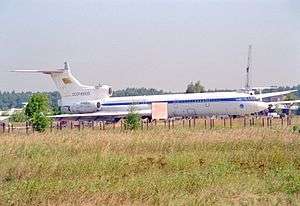Tupolev Tu-155
The Tupolev Tu-155 is a modified Tupolev Tu-154 (СССР-85035) which was used as an alternative fuel testbed. This is the first experimental aircraft in the world operating on liquid hydrogen.[1] The similar Tu-156 was never built.
| Tu-155 | |
|---|---|
 | |
| СССР-85035 | |
| Role | Alternative fuel testbed aeroplane |
| National origin | Soviet Union |
| Manufacturer | Aviakor |
| First flight | 15 April 1988 |
| Primary user | Flight Testing Base of the Tupolev Design Bureau |
| Number built | 1 |
| Developed from | Tupolev Tu-154 |
Design and development
The Tu-155 first flew on 15 April 1988. It used hydrogen fuel and later liquified natural gas (LNG). It flew until the fall of the Soviet Union and it is currently stored at Ramenskoye Airport near Zhukovskiy. The Tu-156 was intended to fly around 1997, but was cancelled also due to the fall of the Soviet Union. The aircraft used cryogenics to store fuel. The fuel tank was located in the air-blown (or nitrogen) rear compartment. A distinctive feature of the aircraft is that the protrusion of the ventilation system is visible on the tail (near the no. 2 engine). The Tu-155 used Kuznetsov NK-88 engines. The Tu-156 was intended to use Kuznetsov NK-89 engines.[2] The Tu-155 flew around 100 flights until it was placed in storage.

References
- Graham E. Dorrington, Glenn Baxter, Cees Bil, Aleksandar Subic, Pavel M. Trivailo (2013). "Prospects for Liquefied Natural Gas and other Alternative Fuels for Future Civil Air Transportation" (PDF). Proceedings of the 15th Australian International Aerospace Congress (AIAC15). Melbourne, Australia: Royal Aeornautical Society, Australia Division: 116–125.CS1 maint: multiple names: authors list (link)
- Dmitriy Komissarov, Tupolev Tu-154, the USSR's Medium-Range Jet Airliner, (Hinckley, UK, 2007), 48–50. ISBN 1-85780-241-1
External links
| Wikimedia Commons has media related to Tupolev Tu-155. |